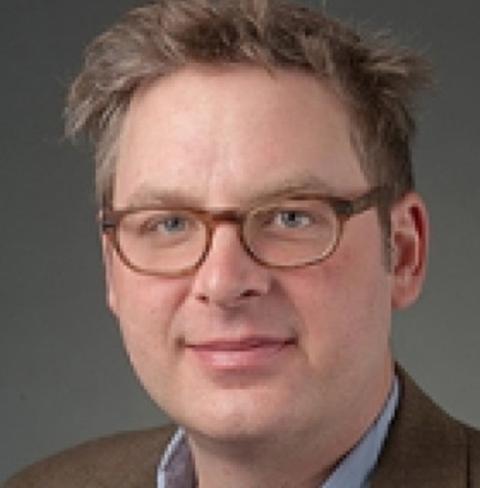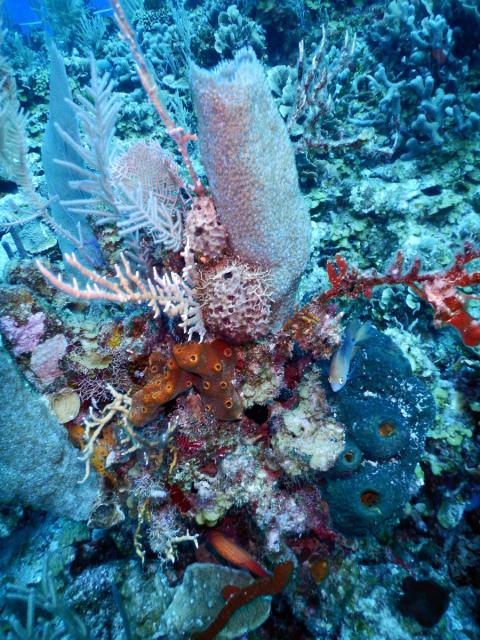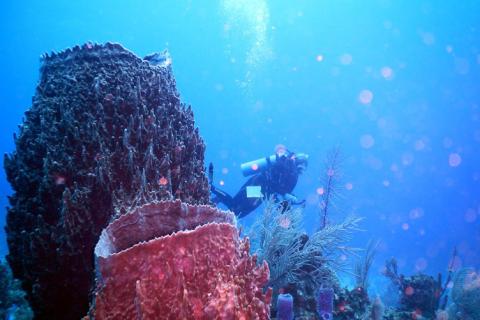Key Findings

Among the 100 Caribbean sponge species, from 1,400 samples, that the researchers characterized, they found two distinct microbiome compositions (low microbial abundance, or LMA, and high microbial abundance, or HMA) that led to different strategies sponges used for feeding (sponges capture nutrients by pumping water through their bodies) and protecting themselves against predators.
The more recently formed of the two compositions, HMA, occurred at a time when the Earth’s oceans underwent a significant change in biogeochemistry coincident with the origins of modern coral reefs.
About the Co-Author

David Plachetzki, Associate Professor of Molecular, Cellular, and Biomedical Sciences
Contact information: David.Plachetzki@unh.edu
603-862-5144, Plachetzki Lab website
This research first published in Nature Ecology & Evolution journal.
Researchers: M. S. Pankey, D. C. Plachetzki, K. J. Macartney, M. Gastaldi, M. Slattery, D. Gochfeld and M. Lesser.
Sponges in coral reefs are among the earliest animals on the planet. Research from UNH examines coral reef ecosystems with a novel approach to understanding the complex evolution of sponges and the microbes that live in symbiosis with them. Using this “genomic time machine,” researchers can predict aspects of reef and ocean ecosystems through hundreds of millions of years of dramatic evolutionary change.
The researchers, which included Sabrina Pankey, a UNH postdoctoral researcher, and David Plachetzki, associate professor of molecular, cellular and biomedical sciences at UNH, published their findings in an article in the journal Nature Ecology & Evolution.
The significance of the work transcends sponges, though, providing a new approach to understanding the past based on genomics. “If we can reconstruct the evolutionary history of complex microbial communities like this we can say a lot about the Earth’s past,” said Plachetzki. “Research like this could reveal aspects of the chemical composition of the Earth’s oceans going back to before modern coral reefs even existed, or it could provide insights on the tumult that marine ecosystems experienced in the aftermath of the greatest extinction in history that took place about 252 million years ago.”
“Research like this could reveal aspects of the chemical composition of the Earth’s oceans going back to before modern coral reefs even existed.”
The researchers characterized almost 100 sponge species from across the Caribbean using a machine-learning method to model the identity and abundance of every member of the sponges’ unique microbiomes, the community of microbes and bacteria that live within them in symbiosis. They found two distinct microbiome compositions that led to different strategies sponges used for feeding (sponges capture nutrients by pumping water through their bodies) and protecting themselves against predators — even among species that grew side by side on a reef.
“This study shows how microbiomes have evolved in a group of organisms over 700 million years old,” sayid Pankey. “Sponges are increasing in abundance on reefs in response to climate change and they play an enormous role in water quality and nutrient fixation.”


This project was funded by National Science Foundation Dimensions of Biodiversity grants OCE-1638296/1638289 and Biological Oceanography Program grants OCE-1632348/1632333. Co-authors include M. S. Pankey, D. C. Plachetzki, K. J. Macartney, M. Gastaldi, M. Slattery, D. Gochfeld and M. Lesser.

